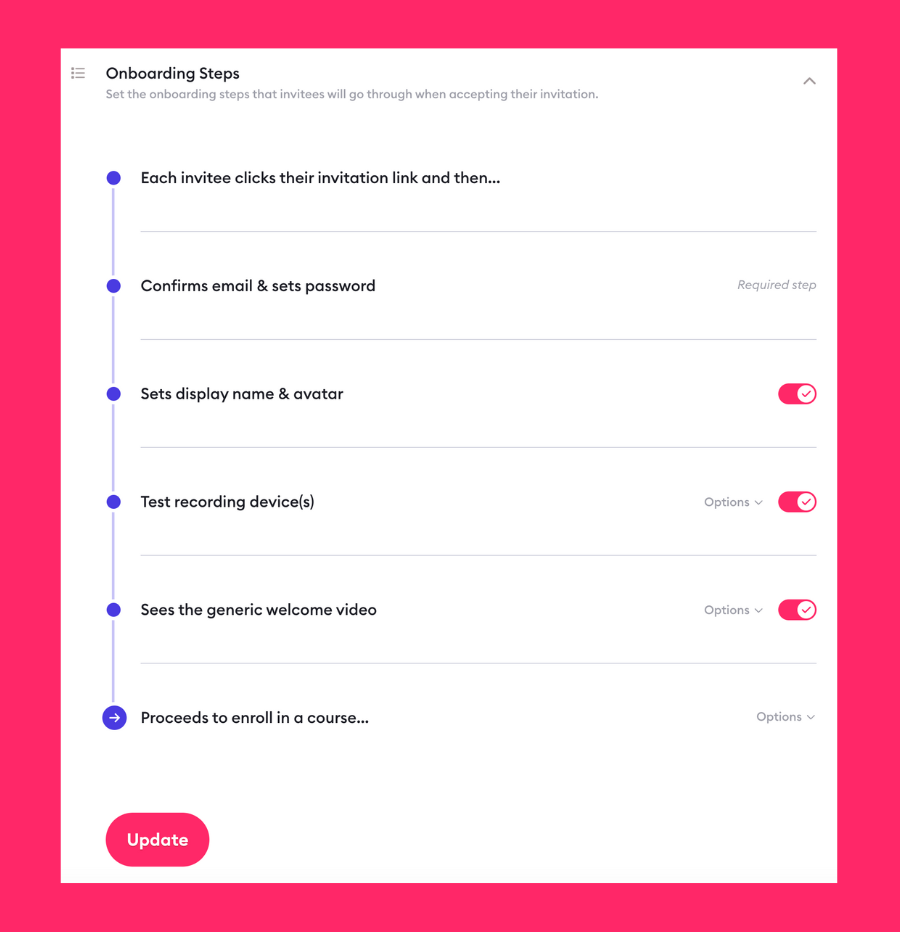Async Coaching Packages: How to Price Them Right

Pricing your coaching packages is always a bit of a puzzle. You want to find a number that your clients are willing to pay but that also represents the value you provide.
And when it comes to putting a price on your asynchronous (async) coaching packages? Well, that feels even more dizzying. With “traditional,” real-time coaching offerings, you have a clearer idea of exactly what you’re charging your clients for. For example, you determine your price for a one-hour live coaching session.
But async coaching isn’t as structured or predictable. It’s hard to know how often your clients will reach out or whether addressing their questions will take you two minutes or 20 minutes.
Scratching your head trying to figure out how to price async coaching packages? This guide covers what you need to know, including:
What exactly are async coaching packages?
Before we get into the nitty-gritty of pricing, let’s start with a quick refresher on this question: What is async coaching?
Async communication is any type of communication that doesn’t rely on real-time (also known as synchronous) communication. Instead, you and the other person swap messages back and forth on your own time—whenever it’s most convenient for you. Think of email. That’s a form of async communication we all know well.
With that definition in mind, async coaching is when you provide your clients with advice and guidance by swapping messages, rather than through a live coaching conversation. However, many coaches use async coaching as a supplement to their real-time offerings—like providing async support for a set amount of time following a live coaching call.
How to price coaching packages: 5 ways to charge for async coaching
One of the biggest struggles with putting a price on your async coaching packages is that they feel a little amorphous.
You’re essentially charging for ongoing support (although, often with parameters—we’ll cover that in a bit). For some clients, that might mean sending dozens of messages and questions in a single week. For others, it might look like submitting a single, thoughtful question in that same amount of time.
With that said, there are quite a few pricing approaches you can use to bring a little more structure when picking a price. Here are five different strategies to consider.
1. Price your async coaching packages based on time
With this approach, you establish a duration of time for your async coaching arrangement and charge for that. Again, it can be tough to know exactly how much client interaction you’ll have during that time. It’s smart to estimate the high end of client interaction and assign a price that accommodates that.
Example: “Receive two weeks of asynchronous coaching for $500.”
2. Price your async coaching packages based on volume
If you’re worried about the frequency of messages and client interactions ballooning out of control, you can structure your async coaching packages based on frequency. With this approach, you charge your clients for the sheer number of messages or questions they can send.
Example: “Receive access to ask me up to three questions per week for a weekly payment of $49.”
INSIDER TIP: Clarityflow makes it easy to turn off replies (it’s a single toggle) so clients can’t post new messages in your conversations. You also have full control over the types of messages clients can send you (audio, video, text, etc.) and the length of any recordings they can submit. You can set these controls at both your account level and the conversation level.

3. Price async coaching as a piece of your coaching packages
“Async coaching is not a separate thing or add-on for me,” explains Nat Olson, a spiritual coach and numerologist. Instead, she incorporates async support as one piece of her overall coaching package. Her price gives clients one month of coaching, which includes two bi-weekly sessions and text support via Clarityflow between those sessions.
Example: “Receive six months of coaching, which includes six live sessions and asynchronous support, for $5,000.”
4. Price async coaching packages as an add-on
You can also go the opposite direction and price your async coaching offerings as a separate add-on to your other coaching packages. This allows your clients to choose whether they want to pay only for live, synchronous coaching conversations or if they want to pay an additional fee to benefit from ongoing, asynchronous support.
Example: “Add ongoing asynchronous support to your monthly coaching calls for an additional $49 per month.”
5. Price async coaching services based on value
Finally, rather than opting for more rigid criteria, you can price your async coaching offerings based on the perceived value you provide. It’s called value-based pricing (as HubSpot explains, think of it with the adage, “A product costs as much as people are willing to pay for it.”). As Nat explains, “What if you simply didn't view it as a separate thing or put a number on it specifically, but instead priced the transformational program as a whole based on the value of the potential results?”
Example: “Clarify your career vision with this $1,600 coaching package.”
Going beyond guesswork: 5 tips to put a price on async
Once you’ve landed on the approach (or combination of approaches) that fits your coaching business best, here are a few more expert-backed tips to keep in mind when pricing your async coaching packages.
1. Figure out what you need
You likely got into coaching because of a passion for helping people. But you’re also running a business—and businesses need to earn money. That’s why Chris Marr, a business coach at The Authoritative Coach, says the best place to start is by figuring out what you need financially from your business.
“What do I want my salary to be?” he says about when he was thinking about his own pricing. “Then that became a number. Then, as you start to play around with what’s possible within that, you start to get to a place where you’ve got some type of idea of what the price actually needs to be.”
He cautions other coaches to not just think about what they need personally, but also about what their business needs. What do you want your business to look like in another three years? Do you plan to hire now or in the future? And perhaps most importantly, what do you want your lifestyle to look like and what prices do you need to charge to get there?
Doing this sort of backward math helps you build a pricing structure that supports your personal and business goals, rather than landing on a random number that “sounds right” for your offering.
2. Tap into your zone of genius
Pricing is important. But Nat warns coaches not to get so focused on pricing that they forget to think about what they’re most interested in.
“What is your zone of genius in supporting others?” she asks, referencing a concept originally coined by psychologist and author, Gay Hendricks. “Do you love texting? Do you love providing video responses with your whole energy and personality on display? Do you have a love for audio?”
Figuring out what aspects of async are the best match for you helps you identify the “unique way that you deliver value and support in async coaching,” Nat adds. “If we get hung up on pricing before checking in with our zone of genius, then it can actually be pretty darn hard to have clarity on pricing from a place of integrity and service.”
3. Set clear boundaries
Most coaches explore async coaching as a method to scale their businesses and untangle money from their time. So, the last thing you want is for async coaching to snowball into 24/7 support for your clients.
That’s why clear boundaries are crucial. Clients should know exactly what to expect when making that purchase. For example:
What hours are you online and accessible?
How quickly can clients expect a response?
Are there certain topics you won’t address asynchronously?
What types of messages are clients allowed to send and what types of messages will they receive in return?
If you believe answers to some of these questions are pertinent when a client is deciding whether or not to purchase, include them directly on the sales page. Beyond that, you can include other boundaries in your onboarding flow or “welcome” message when clients sign up. Doing so ensures you’re both on the same page.’
INSIDER TIP: With Clarityflow, you have full control over each client’s onboarding experience. You can even create your own custom welcome video.

4. Ignore the competition
If you feel confused about pricing, it’s tempting to look at what your competitors are charging and use those clues to set your own prices. However, copying and pasting everybody else’s approach doesn’t implement the other best practices we’ve already covered—like considering your business goals and your zone of genius.
Instead, Chris says your best bet is “pretty much ignoring what everyone else is doing because that does not matter.”
5. Experiment with what works
Your prices aren’t set in stone, so don’t be afraid of a little trial and error. “I’m playing with pricing all the time,” says Chris. “Every time I get a new client, I put the price up. Every month, I put the price up.”
“I’m experimenting to see what’s possible,” he continues. “Where do I start to get pushback? Where do I start to get objections? Where does it start to become a problem?”
Remember, the price you land on today doesn’t need to be your prince forever. Maintain an experimental mindset and pay close attention to what works (and what doesn’t).
Solve your async pricing puzzle
Async coaching offers a lot of benefits for you and your coaching clients. But putting a price on these types of coaching packages can feel squishy at best.
Fortunately, determining your price doesn’t have to involve throwing a dart at a board. Put the above approaches and expert strategies into practice, and you’ll land on a price that works for you, your business, and your clients.
Ready to use async coaching to scale your business? Get started with Clarityflow.



